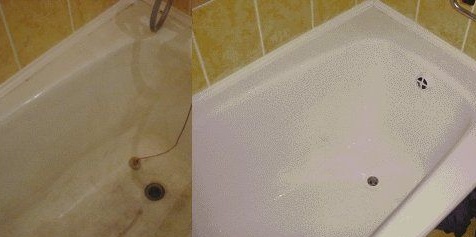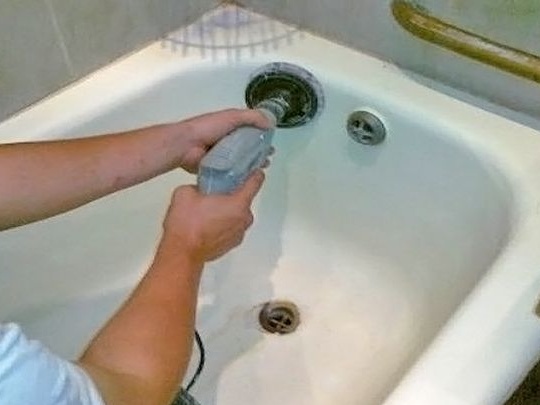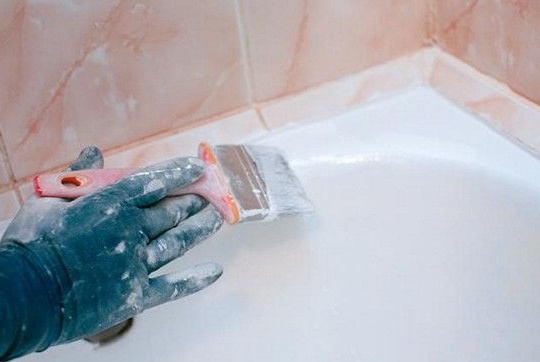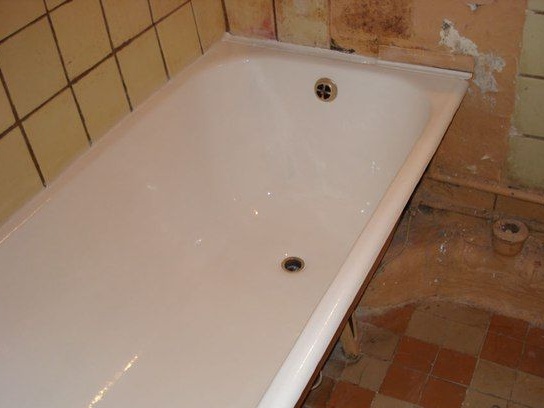
There is nothing eternal ... Any thing in our house eventually wears out and becomes unusable, loses its appearance and requires either repair or replacement with a new one. The item that is in almost every house - an ordinary metal bathtub - will not be an exception.
If your bathtub became unusable, traces of rust or drips from poor-quality tap water appeared on it, and you are painfully considering the question of whether to throw it away or try to put it in order, then this article is for you.
I propose to devote some time to my old bathroom, and it will shine with new colors, as if it were just bought in a store.
Today, construction stores offer a lot of materials to restore the appearance of the bath; Among the variety of materials, we will focus on two-component enamel, with which we enamel our old metal bathtub.
Enamelled metal bathtubs made of cast iron or steel are the most popular bathtub option found in homes today.
How are they enameled at the factory during manufacture? The process is quite simple. First, the bath, or rather its outer surface, is thoroughly heated, after which enamel powder is applied to the inner surface of the bath, which after some time is sintered with the metal surface.
After the powder is sintered, the outer surface of the bath is heated again, as a result of which the powder melts and forms a beautiful glossy coating, which we are used to seeing on the bath.
Naturally, the enameling method described above in home conditions cannot be performed.
What determines the wear and deterioration of enamel in the bath? As a rule, the following factors cause wear: cleaning the bathtub with “aggressive” cleaning agents containing abrasives that damage and thin the enamel during the cleaning process, and poor-quality tap water “enriched” with a lot of chemicals that also negatively affect the enamel.
In addition, the enamel also breaks off as a result of hitting it with something heavy, for example, a metal basin that has fallen out of hands.
All this leads to the fact that after some time, the enamel begins to darken, rust appears, chips and roughness appear.
The process of restoring the enamel coating on the bath is quite simple and consists in preparing the surface of the bath, removing the old enamel and applying a new enamel layer.
To do this, we need to prepare: an electric drill with a special nozzle - a grinding wheel, sandpaper, degreaser, napkins or rags that do not leave fibers and threads, several brushes or a spray gun, in fact, the two-component enamel itself, consisting of two substances (the enamel and hardener itself ) and abrasive powder.
Before performing restoration of the bath cover, it is necessary to dismantle the water drainage mechanism by disconnecting the bath from the drain system. This can be done by spinning the drain system, helping yourself with a screwdriver; then disconnect it from the bath.
We begin surface preparation. Pay attention to the importance of this action, because the better the surface of the bath is cleaned, the better and more evenly the enamel layer will “lay down” during application. First, sprinkle the surface covered with old enamel with abrasive powder, after which we begin to clean off the enamel, helping ourselves with sandpaper or with a grinding wheel and a drill.

We pay even closer attention to areas with rust: we process rust-affected areas with a rust converter, we stand the time according to the instructions for the converter and wash it off. After that, we clean everything with sandpaper, carefully wash the bath and process it with a degreaser.
Next, fill the bath with hot water; wait ten minutes until the bath heats up well, and drain the water by wiping the bath dry with napkins or rags. Please note that when wiping on the bath, there should be no lint from napkins or small debris, dust.
After preparing the bath, proceed to the application of enamel. To do this, mix the enamel and hardener in the proportions and order specified on the manufacturer's instructions; apply a layer of the mixture to the surface of the bath with a brush or spray and wait a while until the layer hardens, according to the instructions. After, in the same order, apply the second, “finish” layer of the mixture.

Major restoration work completed; Now you need to wait until the enamel has completely hardened and not use the bathroom until this moment; as a rule, manufacturers of enamels recommend waiting about seven days from the moment the enamel is applied to the bath.


